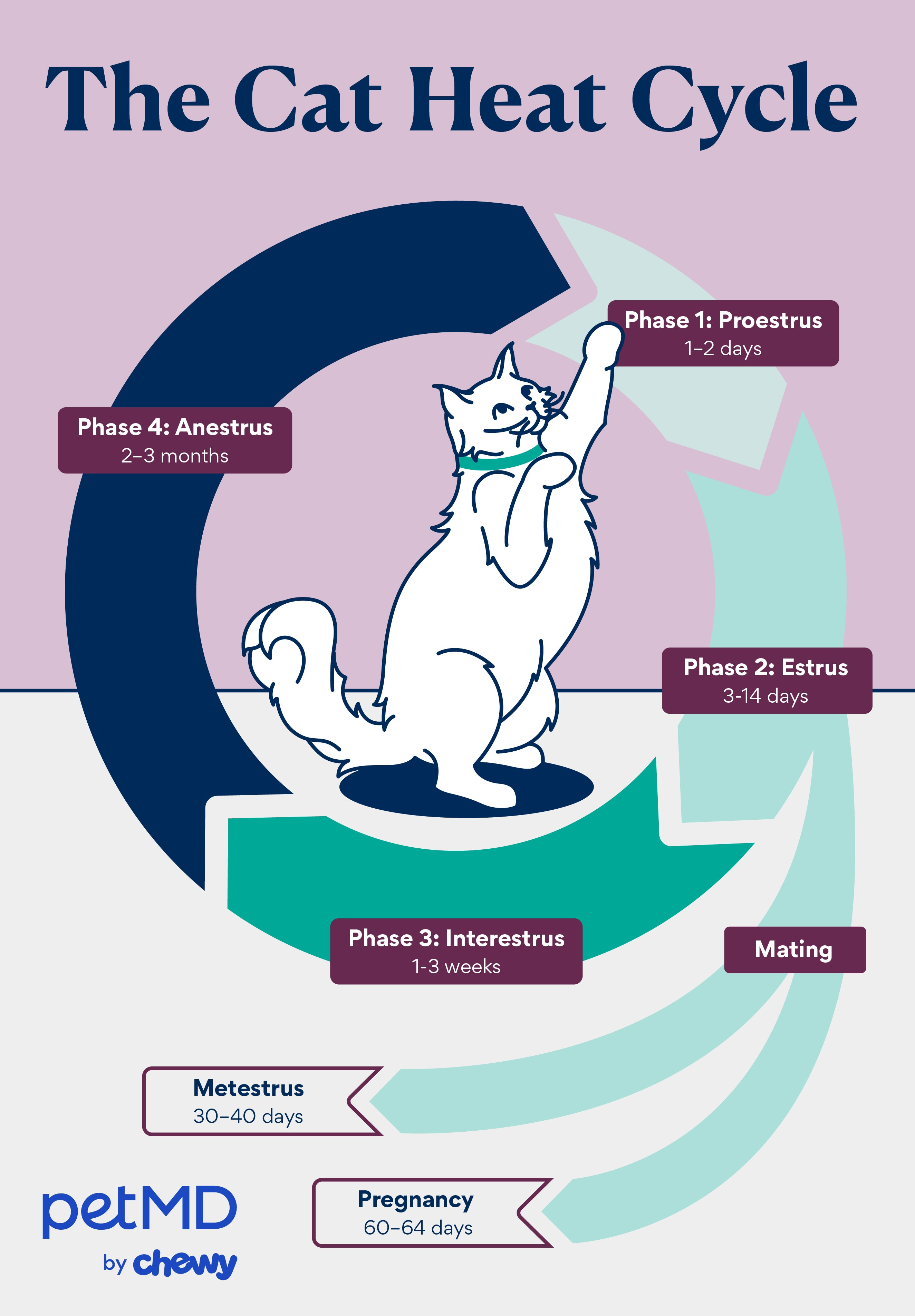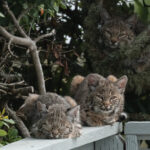For cat owners who haven’t spayed their female felines, understanding the Cat Heat Cycle, also known as the estrous cycle, is crucial. Unlike dogs or humans, the feline heat cycle has unique characteristics. Recognizing the signs of a cat in heat is essential for responsible pet ownership and preventing unwanted pregnancies.
Decoding the Age of Onset: When Do Cats Start Heat Cycles?
Generally, cats begin their heat cycles between 5 and 9 months of age. However, this can vary significantly. Some kittens may start as early as 3-4 months, while others might not experience their first cycle until they are 18 months old. Several factors influence this timing, including breed, weight, and even the time of year.
Duration and Stages: How Long Does a Cat’s Heat Cycle Last?
The cat heat cycle isn’t a single event but a series of stages, each with distinct characteristics and durations. It’s important to understand these stages to properly care for your cat.
 Illustration depicting a cat in heat with visible signs like restlessness and vocalization
Illustration depicting a cat in heat with visible signs like restlessness and vocalization
The cycle consists of four primary stages:
Proestrus: The Prelude to Heat
Proestrus is the initial stage, marked by rising estrogen levels. This phase typically lasts just one to two days and often goes unnoticed by owners as there are no outwardly visible symptoms. During proestrus, male cats might show increased interest, but the female cat will not be receptive to mating.
Estrus: The Peak of the Heat Cycle
Estrus is the most recognizable phase of the cat heat cycle, often lasting about a week, but it can range from 3 to 14 days. This is what most people refer to when they say a cat is “in heat.”
During estrus, female cats, also known as queens, exhibit noticeable behavioral changes. They may become excessively affectionate, demanding attention from their owners and even rubbing against furniture. Vocalization is another common sign; cats in heat often become very vocal, meowing, yowling, or caterwauling to attract male cats. Restlessness is also typical, with cats pacing, rolling around, or trying to escape outdoors to find a mate. This is the stage when mating occurs if the cat is allowed to interact with a male cat.
Interestrus and Metestrus: Intervals Between Estrus
Interestrus and metestrus represent the periods between estrus cycles and are crucial to understanding feline reproductive biology. Cats are induced ovulators, meaning they only release eggs from their ovaries after mating.
- Metestrus: If a cat in estrus mates, ovulation occurs, and the cycle pauses. If fertilization does not occur, the cat enters metestrus, a stage lasting 30–40 days.
- Pregnancy: If fertilization happens, it leads to pregnancy, which lasts approximately 60–64 days.
- Interestrus: If a cat in estrus does not mate or ovulate, she enters interestrus. In this phase, in-heat behaviors subside for one to three weeks before the cycle restarts with proestrus.
Anestrus: The Period of Reproductive Inactivity
Cats are seasonal breeders, and anestrus is the period of reproductive inactivity. This phase typically occurs during the shorter daylight months, usually lasting for two to three months during winter. During anestrus, there is minimal hormonal activity, and the cat does not cycle.
Frequency of Heat Cycles: How Often Do Cats Go into Heat?
Cat heat cycles are heavily influenced by seasonal changes and daylight hours. As “long-day breeders,” cats experience more frequent heat cycles as daylight hours increase, starting in spring and peaking from February to April. These cycles can continue until October or November, only interrupted by pregnancy, before anestrus begins again.
Recognizing the Signs: How to Tell If Your Cat Is in Heat
Unlike dogs and humans, cats do not experience bleeding during their heat cycle. The primary indicators are behavioral changes. A cat in heat might display several signs:
- Increased Affection: Becoming overly affectionate towards humans and other pets in the household, seeking constant attention and physical contact.
- Excessive Vocalization: Meowing, yowling, and making other noises more frequently and intensely than usual, often sounding distressed or demanding.
- Reduced Appetite: Showing a decrease in interest in food, eating less than normal.
- Restlessness: Pacing, agitation, and an inability to settle down or relax.
- Urine Marking (Less Common): In some cases, cats in heat may urinate more frequently or outside the litter box, though this is less common than other signs.
It’s understandable for pet owners to be concerned that their cat is in pain due to the intensity of these behavioral changes. If you notice any sudden or severe behavioral shifts, consulting with your veterinarian is always recommended to rule out any underlying health issues.
Managing a Cat in Heat: What to Do
The most important consideration when your cat is in heat is preventing unwanted pregnancies. If you do not intend to breed your cat, she should be kept indoors during her heat cycle to avoid contact with male cats.
Aside from preventing pregnancy, there are typically no other necessary lifestyle changes for a cat in heat. However, it’s crucial to monitor the length and frequency of her heat cycles. Be vigilant for potential complications such as pseudopregnancy (false pregnancy) or mucometra (mucus accumulation in the uterus). Pyometra, a severe uterine infection, is a life-threatening condition that can occur at any age but is more common in middle-aged cats.
Seek veterinary attention immediately if your cat exhibits any of these symptoms during or after her heat cycle:
- Lethargy or weakness
- Loss of appetite
- Vomiting or diarrhea
- Fever
- Abdominal swelling
- Pus-like or bloody vaginal discharge
Preventing Heat Cycles: The Importance of Spaying
Spaying, which involves surgically removing the uterus and ovaries, is the only definitive way to prevent heat cycles and pregnancy in female cats. Unless you are a responsible breeder and your cat is part of a planned breeding program, spaying is highly recommended.
Spaying offers numerous health and behavioral benefits. It eliminates the frustrating behaviors associated with heat cycles and significantly reduces the risk of pyometra, pseudopregnancy, mammary cancer, and ovarian cancer.
There are no proven health benefits to allowing a cat to experience a heat cycle before spaying. Veterinarians recommend spaying kittens at 5–6 months of age, ideally before their first heat cycle, to prevent these cycles altogether and provide optimal health protection.
Frequently Asked Questions About Cats in Heat
Do cats bleed when they are in heat?
No, cats should not bleed during a heat cycle. Any vaginal bleeding is abnormal and warrants an immediate veterinary examination as it could indicate a serious health problem. While a clear vaginal discharge can sometimes occur during proestrus, blood is not a normal occurrence.
Can you spay a cat while she is in heat?
Yes, spaying a cat in heat is possible and often necessary. Delaying spaying to wait for anestrus would expose the cat to the risks of repeated heat cycles and potential pregnancy. Spaying during heat is considered safe, although there might be a slightly increased risk of bleeding due to increased blood flow to the reproductive organs.
Do male cats go into heat?
No, male cats do not experience heat cycles. Heat cycles are specific to female mammals and involve the ovaries and associated hormonal changes. Male cats, however, are capable of mating at any time once they reach sexual maturity.
How long does a cat’s heat cycle last?
The estrus phase, or the “in heat” phase with visible behavioral changes, typically lasts for an average of one week, with a range of 3 to 14 days. The entire estrous cycle, including other stages, is longer, but the most noticeable and behaviorally significant part is estrus.
How can I be sure if my cat is in heat?
If you suspect your cat is in heat, observe her behavior for the signs mentioned earlier, such as increased vocalization, affection, and restlessness. If you are unsure, consult your veterinarian. They can confirm if your cat is in heat and advise on appropriate care and preventative measures like spaying.


